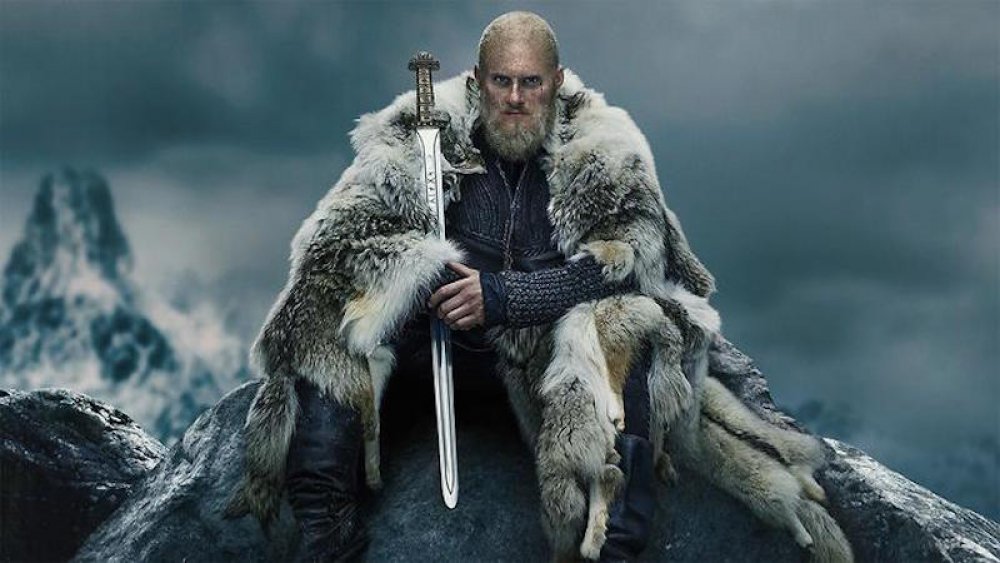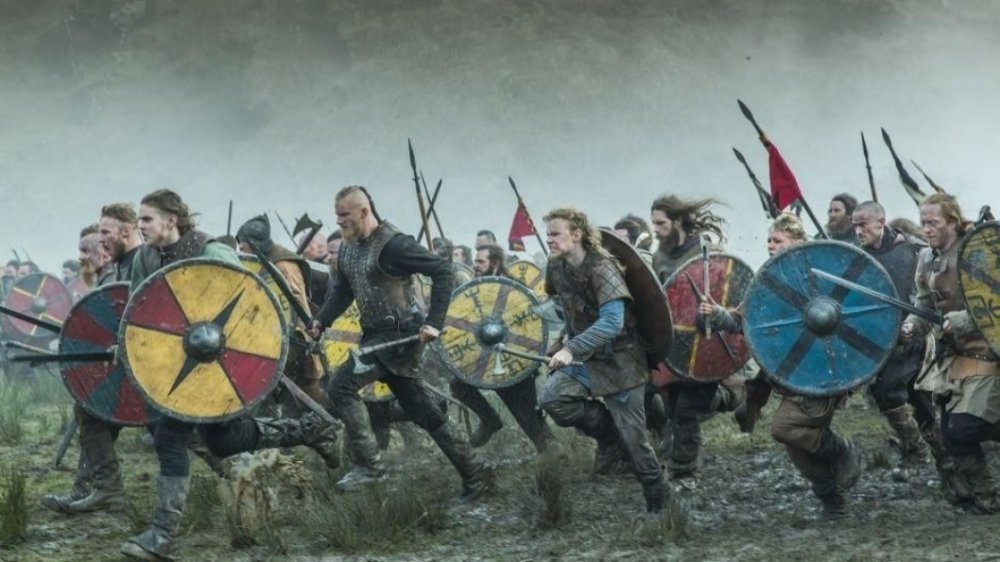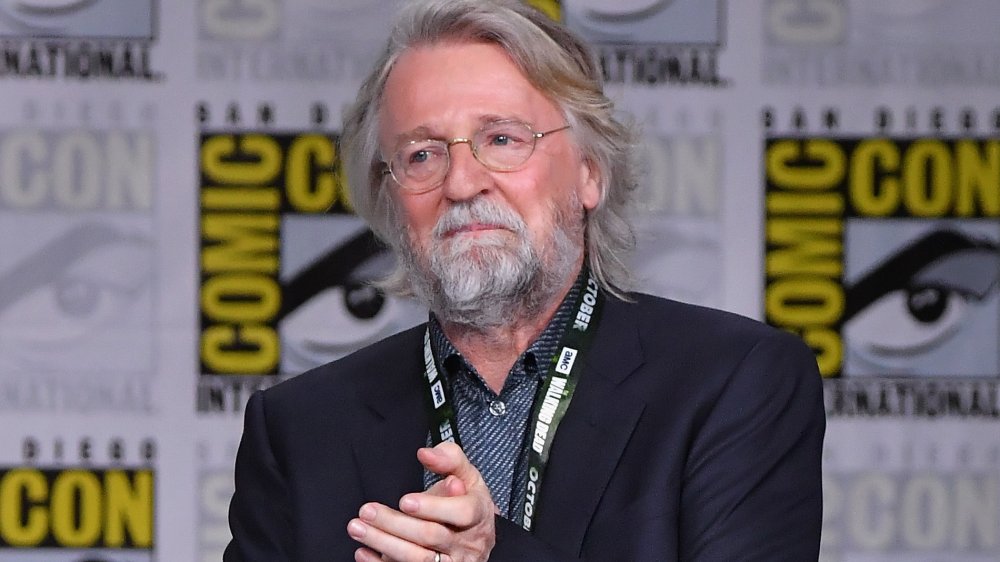The Real Reason This Major Character Is Missing From Vikings
History's hit historical drama Vikings is currently in the final hiatus of its run. Some time later this year, viewers will get to see the epic conclusion of Scandinavian saga, and learn the fates of Ragnar's surviving sons ... well, except for one of them, who was unceremoniously left out of the series altogether.
If you've been following Vikings, you probably think that Vikings' original protagonist Ragnar Lothbrok (Travis Fimmel) sired enough bloodthirsty sons to satisfy any medieval Norweigian king. Between Björn Ironside (Alexander Ludwig), Ubbe (Jordan Patrick Smith), Sigurd Snake-in-the-Eye (David Lindström), Hvitserk (Marco Ilsø), and the diabolical Ivar the Boneless (Alex Høgh Andersen), Ragnar made pretty certain that his legacy would be secure. Interestingly, these characters are more than mere invention, as we actually have historical sources for the existence of all the sons of Ragnar portrayed on the show. According to our best sources, the historical Ragnar did indeed have two wives, the Queen Aslaug (Alyssa Sutherland) and the shieldmaiden Lagertha (Katheryn Winnick), and those two wives actually bore him more sons than we get to see squabbling on Vikings.
Aside from passing references in The Anglo-Saxon Chronicle, our best contemporaneous information about the life of Ragnar Lothbrok and his sons comes from the Sagas, an incomplete collection of Norse, Danish, Swedish and Icelandic mythology from the Viking Age that only survives in partial form. While some scholars have argued that the accounts of Ragnar and his progeny should be taken as folklore or mere myth, some of the events chronicled in these stories line up well with the better-sourced English histories of the Great Heathen Invasion. According to this "historical" record, Vikings is missing one of Ragnar's sons.
The Sagas tell us about the six sons of Ragnar Lothbrok
During the time period alluded to in the Sagas and explicitly covered by History's Vikings, a massive Scandinavian army landed on the northern and eastern coasts of England, and very nearly wiped out the dominant Anglo-Saxon civilization through successive waves of invasion. The events of these Viking invasions were dramatized on the fourth and fifth seasons of Vikings, in which the sons of Ragnar sailed to England to avenge the murder of their father at the hands of the Northumbrian King Aelle (Ivan Kaye). Interestingly, Ragnar's death in a Northumbrian snake pit also comes directly from the Sagas.
The historical record includes references to all the sons of Ragnar that fans of the series have come to know, love and loathe. Ubbe and Ivar, in particular, play an outsized role in the historical Heathen Invasion of England. The historical accounts also make reference, however, to another Lothbrok of arguably greater import than many of the characters who are included on the show. Halfdan Ragnarsson was supposedly a Viking war lord alongside his brothers Ubbe and Ivar. He led men in the Great Heathen Army of the 860s, and nearly wiped Wessex off the map. So, where is he on Vikings?
According to Norse lore, Halfdan led a remarkable life
Halfdan is named in the Sagas, but also in Icelandic epic poetry. He is explicitly cited as one of the many sons of Viking hero Ragnar Lothbrok. According to these literary accounts, he is believed to be a blood sibling to Ivar, Sigurd, Ubbe and Hvitserk, marking him as the fifth son of Queen Aslaug, Ragnar's second wife. Since both Ragnar and Aslaug have already been dispatched on Vikings, we know no additional son is forthcoming from their union. Was this just an oversight? What gives?
Halfdan's exclusion wasn't for lack of source material. He lived an impactful life at least on par with that of his siblings. The historical record places Halfdan in Wessex proper at the time of the Great Heathen Invasion. He apparently joined with the Saxons in battle six times, and, after an unsuccessful assault on Winchester, accepted a truce from Alfred the Great. Halfdan retreated with his army to the Danish-occupied city of Lundene (modern-day London), at the time a minor trading outpost in the neighboring Kingdom of Mercia. He ultimately settled in Northumbria, a region of England under extensive Danish control at the time. He died there some time around 877.
Even though Vikings played around with the timing of these events, Halfdan's historical accomplishments certainly intersected substantially enough with the story creator Michael Hirst was trying to tell to merit at least some consideration.
Why was Halfdan Ragnarsson snubbed by Vikings?
According to Express UK, Hirst actually had a rational historical reason for excluding Halfdan from his series. Per Hirst's research prior to drafting the pilot, he discovered that the Norse sagas he was mining for source material never mention Halfdan and Hvitserk in the same account. Hvitserk is the name favored in Norse stories, whereas Halfdan is cited in the Anglo-Saxon accounts. As a result, some scholars have reached the conclusion that Halfdan and Hvitserk may actually be the same person. Since the whole Lothbrok saga is of dubious historicity, it's entirely possible that this would be the case.
Instead of bloating the cast with an additional Lothbrok son, Hirst opted to agree with the scholars arguing that Halfdan and Hvitserk wer one and the same. So, in some sense, Halfdan is included in the popular series – just under a different name.
The first half of Vikings season 6 is currently streaming on Amazon Prime and History. Catch up before the final raiding party launches by the end of 2020.



